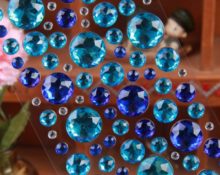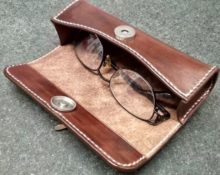Decorating with thermal rhinestones requires special equipment. The finished composition can be attached using an iron available in any household. But a complex, independently developed pattern will require a special soldering iron. How to use this device?
Description of the device
It looks something like this:
- small plastic case (about 20 cm including nozzle);
- a set of nozzles of different sizes + a small container for storing them;
- Foldable stand with folding metal ear, convenient and compact.
Advice! Pay attention to the recess under the soldering iron holder - you can put hot tips removed from the device during operation there. It will help you avoid damaging your workbench by accidentally placing hot attachments on it!
 As a rule, the plug fits all types of sockets, and the power cord is quite long (a little more than a meter).The device is easy to use: there is no risk of burning your fingers thanks to additional thermal protection, allowing you to work comfortably.
As a rule, the plug fits all types of sockets, and the power cord is quite long (a little more than a meter).The device is easy to use: there is no risk of burning your fingers thanks to additional thermal protection, allowing you to work comfortably.
Nozzles are available in two types: flat – for gluing round rhinestones, and equipped with a recess and slot – for products of standard sizes, placed in a recess and held with tweezers using a slot.
Advice! Don't throw away the packaging box! In addition to the convenience of storing the device in it, it has informational functions: the rules for using the device are written on it, and the pictures clearly explain which attachment is suitable for specific rhinestones.
The soldering iron clearly beats the iron in technical capabilities: portable and lightweight, it allows you to evenly heat every small part, ensuring its secure attachment to the fabric. It is much easier for them to operate in hard-to-reach places and on small parts like pockets or collars. It is also suitable for decorating bags and shoes.
The working principle of a soldering iron for rhinestones
 The device is designed for heat treatment of the adhesive surface of jewelry. If an iron “smoothes” an entire shining composition at the same time (sometimes hopelessly damaging the fabric), then the soldering iron works precisely and for sure: each rhinestone was heated up, then glued. Suitable for connoisseurs of meticulous work!
The device is designed for heat treatment of the adhesive surface of jewelry. If an iron “smoothes” an entire shining composition at the same time (sometimes hopelessly damaging the fabric), then the soldering iron works precisely and for sure: each rhinestone was heated up, then glued. Suitable for connoisseurs of meticulous work!
We work with a soldering iron according to the instructions
First, we prepare the workplace and everything necessary. There should be enough space to lay out the item to be decorated (a wooden base is ideal, a thermal cloth will also work). The rhinestones and the apparatus for gluing them should be conveniently at hand.
Advice! Before you start, make sure you bought the right thermal rhinestones? It is easy to distinguish them from similar products for cold fixation by the hot-melt adhesive backing - black or gray. Not detected? We put away the soldering iron and run to the store for glue. Or - for matching rhinestones!
Having settled comfortably, let's get to work:
 choose a suitable nozzle, focusing on the size of the “pebble” and the characteristics of the material;
choose a suitable nozzle, focusing on the size of the “pebble” and the characteristics of the material;- put the nozzle on the device - making sure that the soldering iron is turned off;
- Having placed the device on the stand, plug the plug into the socket and wait for half a minute;
- glue the decor onto the fabric.
There are two ways of gluing. First: the rhinestone is placed face up on the fabric, then we heat the “pebble” with a soldering iron. It is convenient if the drawing was laid out ahead of time. Both flat and concave nozzles are suitable.
The second method involves first laying out the rhinestones on paper or a substrate. Then we heat the rhinestone with a soldering iron for up to five seconds - it will stick to the nozzle due to the heating of the glue. Now you can transfer it to the fabric. The method is good if you select a nozzle with a concave bottom and strictly according to the size of the “stone”.
Important! The thinner the fabric, the shorter the contact time of the rhinestones with the soldering iron. It is recommended to start with five seconds.
Let's not forget about safety precautions. In addition to the rules for working with electrical appliances, we take into account the ability of the soldering iron to heat up - tweezers and wooden sticks (for example, manicure sticks) will help protect against burns.


 choose a suitable nozzle, focusing on the size of the “pebble” and the characteristics of the material;
choose a suitable nozzle, focusing on the size of the “pebble” and the characteristics of the material; 0
0





